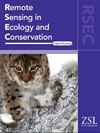A UAV‐based deep learning pipeline for intertidal macrobenthos monitoring: Behavioral and age classification in Tachypleus tridentatus
IF 4.3
2区 环境科学与生态学
Q1 ECOLOGY
引用次数: 0
Abstract
Intertidal macrobenthos are vital bioindicators of coastal ecosystem health due to their ecological roles, limited mobility, and sensitivity to environmental disturbances. However, traditional field‐based monitoring methods are time‐consuming, spatially restricted, and unsuitable for large‐scale ecological surveillance. Integrating unmanned aerial vehicles (UAVs) with deep learning offers a promising alternative for high‐resolution, cost‐effective monitoring. Yet, species‐specific object detection frameworks for mobile macrobenthic fauna remain underdeveloped.基于无人机的潮间带大型底栖动物监测的深度学习管道:三叉戟鲎的行为和年龄分类
潮间带大型底栖动物具有重要的生态作用、有限的流动性和对环境干扰的敏感性,是沿海生态系统健康的重要生物指标。然而,传统的野外监测方法耗时长、空间有限,不适合大规模的生态监测。将无人机(uav)与深度学习相结合,为高分辨率、高成本效益的监测提供了一种有前景的替代方案。然而,针对移动大型底栖动物的物种特异性目标检测框架仍然不发达。tridentatus Tachypleus tridentatus是一种具有4.3亿年进化史的濒危“活化石”,具有重要的生态意义和生物医学价值,是潮间带保护的旗舰物种。本研究将基于无人机的图像采集、自动检测和生态特征推断相结合,开发了一种定制的三叉戟天牛监测深度学习管道。我们构建了第一个无人机衍生的幼年三叉齿鼠数据集(n = 761),并实现了一个卷积自编码器用于无监督行为分类,在区分埋藏个体和暴露个体方面达到了96%的准确率。利用轻量级剪枝和高低频融合模块(HLFM)对基于YOLO的检测模型进行了优化,提高了检测精度(mAP@50提高了1.74%)和计算效率。此外,我们建立了将爬行痕迹宽度与前体宽度(R2 = 0.99)和前体宽度与龄期(R2 = 0.91)联系起来的稳健回归模型。推断的年龄阶段在数据集之间没有显着偏差,验证了它们作为年龄结构指标的使用。通过将物种水平的检测与种群水平的生态推断联系起来,本研究为三叉戟河鼠和其他潮间带大型底栖动物类群的监测提供了一个可扩展的、可现场部署的框架。该方法支持数据驱动的保护策略,增强了我们在复杂潮间带环境中评估濒危沿海物种状况的能力。
本文章由计算机程序翻译,如有差异,请以英文原文为准。
求助全文
约1分钟内获得全文
求助全文
来源期刊

Remote Sensing in Ecology and Conservation
Earth and Planetary Sciences-Computers in Earth Sciences
CiteScore
9.80
自引率
5.50%
发文量
69
审稿时长
18 weeks
期刊介绍:
emote Sensing in Ecology and Conservation provides a forum for rapid, peer-reviewed publication of novel, multidisciplinary research at the interface between remote sensing science and ecology and conservation. The journal prioritizes findings that advance the scientific basis of ecology and conservation, promoting the development of remote-sensing based methods relevant to the management of land use and biological systems at all levels, from populations and species to ecosystems and biomes. The journal defines remote sensing in its broadest sense, including data acquisition by hand-held and fixed ground-based sensors, such as camera traps and acoustic recorders, and sensors on airplanes and satellites. The intended journal’s audience includes ecologists, conservation scientists, policy makers, managers of terrestrial and aquatic systems, remote sensing scientists, and students.
Remote Sensing in Ecology and Conservation is a fully open access journal from Wiley and the Zoological Society of London. Remote sensing has enormous potential as to provide information on the state of, and pressures on, biological diversity and ecosystem services, at multiple spatial and temporal scales. This new publication provides a forum for multidisciplinary research in remote sensing science, ecological research and conservation science.
 求助内容:
求助内容: 应助结果提醒方式:
应助结果提醒方式:


